Stewart J. Calculus
Подождите немного. Документ загружается.


figure. Use Simpson’s Rule to estimate the area of the pool.
31. (a) Use the Midpoint Rule and the given data to estimate the
value of the integral .
(b) If it is known that for all , estimate the
error involved in the approximation in part (a).
32. A radar gun was used to record the speed of a runner during
the first 5 seconds of a race (see the table). Use Simpson’s
Rule to estimate the distance the runner covered during those
5 seconds.
The graph of the acceleration of a car measured in
is shown. Use Simpson’s Rule to estimate the increase in the
velocity of the car during the 6-second time interval.
34. Water leaked from a tank at a rate of liters per hour, where
the graph of is as shown. Use Simpson’s Rule to estimate the
total amount of water that leaked out during the first 6 hours.
r
0
642
2
4
t (seconds)
r
r!t#
a
0
642
4
8
12
t (seconds)
ft"s
2
a!t#
33.
x$4 % f ,!x# % 1
x
3.2
0
f !x# dx
6.2
5.0
7.2
6.8
5.6
4.8
4.8
have no problem computing and graphing it, so we can
easily find a value for from a machine graph. This exercise
deals with approximations to the integral ,
where .
(a) Use a graph to get a good upper bound for .
(b) Use to approximate .
(c) Use part (a) to estimate the error in part (b).
(d) Use the built-in numerical integration capability of your
CAS to approximate .
(e) How does the actual error compare with the error esti-
mate in part (c)?
(f) Use a graph to get a good upper bound for .
(g) Use to approximate .
(h) Use part (f) to estimate the error in part (g).
(i) How does the actual error compare with the error esti-
mate in part (h)?
( j) How large should be to guarantee that the size of the
error in using is less than ?
24. Repeat Exercise 23 for the integral .
25–26 Find the approximations , and for ,
and . Then compute the corresponding errors , and
. (Round your answers to six decimal places. You may wish to
use the sum command on a computer algebra system.) What
observations can you make? In particular, what happens to the
errors when is doubled?
25. 26.
27–28 Find the approximations , , and for and .
Then compute the corresponding errors , and . (Round
your answers to six decimal places. You may wish to use the sum
command on a computer algebra system.) What observations can
you make? In particular, what happens to the errors when is
doubled?
27. 28.
29. Estimate the area under the graph in the figure by using
(a) the Trapezoidal Rule, (b) the Midpoint Rule, and
(c) Simpson’s Rule, each with .
30. The widths (in meters) of a kidney-shaped swimming pool
were measured at 2-meter intervals as indicated in the
1
x
y
0
43
6521
n ! 6
y
4
1
1
s
x
dx
y
2
0
x
4
dx
n
E
S
E
T
, E
M
12n ! 6S
n
M
n
T
n
y
2
1
1
x
2
dx
y
1
0
xe
x
dx
n
E
M
E
L
, E
R
, E
T
20
n ! 5, 10M
n
L
n
, R
n
, T
n
y
1
$1
s
4 $ x
3
dx
CAS
0.0001S
n
n
IS
10
$
f
!4#
!x#
$
I
IM
10
$
f ,!x#
$
f !x# ! e
cos x
I ! x
2
+
0
f !x# dx
K
f
!4#
542
|| ||
CHAPTER 8 TECHNIQUES OF INTEGRATION
x x
0.0 6.8 2.0 7.6
0.4
6.5 2.4 8.4
0.8
6.3 2.8 8.8
1.2
6.4 3.2 9.0
1.6
6.9
f !x#f !x#
t (s) (m"s) t (s) (m"s)
0 0 3.0 10.51
0.5
4.67 3.5 10.67
1.0
7.34 4.0 10.76
1.5
8.86 4.5 10.81
2.0
9.73 5.0 10.81
2.5 10.22
vv
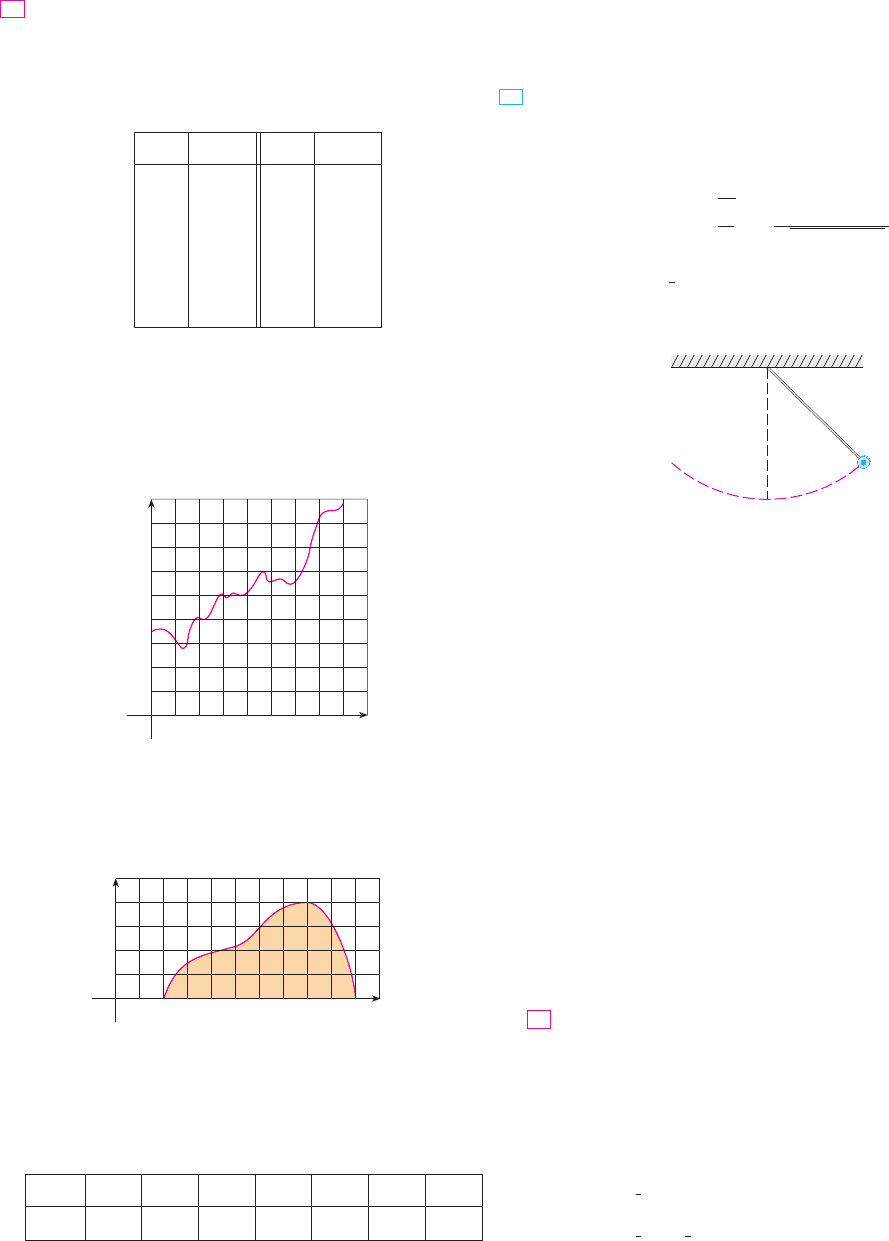
39. The region bounded by the curves , , ,
and is rotated about the -axis. Use Simpson’s Rule
with to estimate the volume of the resulting solid.
40. The figure shows a pendulum with length that makes a
maximum angle with the vertical. Using Newton’s
Second Law, it can be shown that the period (the time
for one complete swing) is given by
where and is the acceleration due to gravity.
If m and , use Simpson’s Rule with to
find the period.
41. The intensity of light with wavelength traveling through
a diffraction grating with slits at an angle is given by
, where and is the
distance between adjacent slits. A helium-neon laser with
wavelength is emitting a narrow band
of light, given by , through a grating with
10,000 slits spaced apart. Use the Midpoint Rule
with to estimate the total light intensity
emerging from the grating.
42. Use the Trapezoidal Rule with to approximate
. Compare your result to the actual value.
Can you explain the discrepancy?
43. Sketch the graph of a continuous function on for which
the Trapezoidal Rule with is more accurate than the
Midpoint Rule.
44. Sketch the graph of a continuous function on for which
the right endpoint approximation with is more accurate
than Simpson’s Rule.
If is a positive function and for , show
that
46. Show that if is a polynomial of degree 3 or lower, then
Simpson’s Rule gives the exact value of .
47. Show that .
48. Show that .
1
3
T
n
!
2
3
M
n
! S
2n
1
2
!T
n
! M
n
# ! T
2n
x
b
a
f !x# dx
f
T
n
)
y
b
a
f !x# dx
)
M
n
a % x % bf ,!x#
)
0f
45.
n ! 2
(0, 2)
n ! 2
(0, 2)
x
20
0
cos!
+
x# dx
n ! 10
x
10
$6
$10
$6
I!
-
#
d
-
n ! 10
10
$4
m
$10
$6
)
-
)
10
$6
.
! 632.8 & 10
$9
m
dk ! !
+
Nd sin
-
#"
.
I!
-
# ! N
2
sin
2
k"k
2
-
N
.
¨¸
n ! 10
-
0
! 42/L ! 1
tk ! sin
(
1
2
-
0
)
T ! 4
+
L
t
y
+
"2
0
dx
s
1 $ k
2
sin
2
x
T
-
0
L
CAS
n ! 8
xx ! 5
x ! 1y ! 0y ! e
$1"x
The table (supplied by San Diego Gas and Electric) gives the
power consumption in megawatts in San Diego County
from midnight to 6:00
AM on December 8, 1999. Use Simp-
son’s Rule to estimate the energy used during that time
period. (Use the fact that power is the derivative of energy.)
36. Shown is the graph of traffic on an Internet service pro-
vider’s T1 data line from midnight to 8:00
AM. is the data
throughput, measured in megabits per second. Use Simpson’s
Rule to estimate the total amount of data transmitted during
that time period.
37. If the region shown in the figure is rotated about the -axis to
form a solid, use Simpson’s Rule with to estimate the
volume of the solid.
38. The table shows values of a force function , where is
measured in meters and in newtons. Use Simpson’s Rule
to estimate the work done by the force in moving an object a
distance of 18 m.
f !x#
xf !x#
0
4
4
10
2
86
2
y
x
n ! 8
y
0
0.4
4 6
0.8
2 8
D
t (hours)
D
P
35.
SECTION 8.7 APPROXIMATE INTEGRATION
|| ||
543
t P t P
0:00 1814 3:30 1611
0
:30
1735 4:00 1621
1:00
1686 4:30 1666
1:30
1646 5:00 1745
2:00
1637 5:30 1886
2:30 1609 6:00 2052
3:00 1604
x 0 3 6 9 12 15 18
9.8 9.1 8.5 8.0 7.7 7.5 7.4f !x#
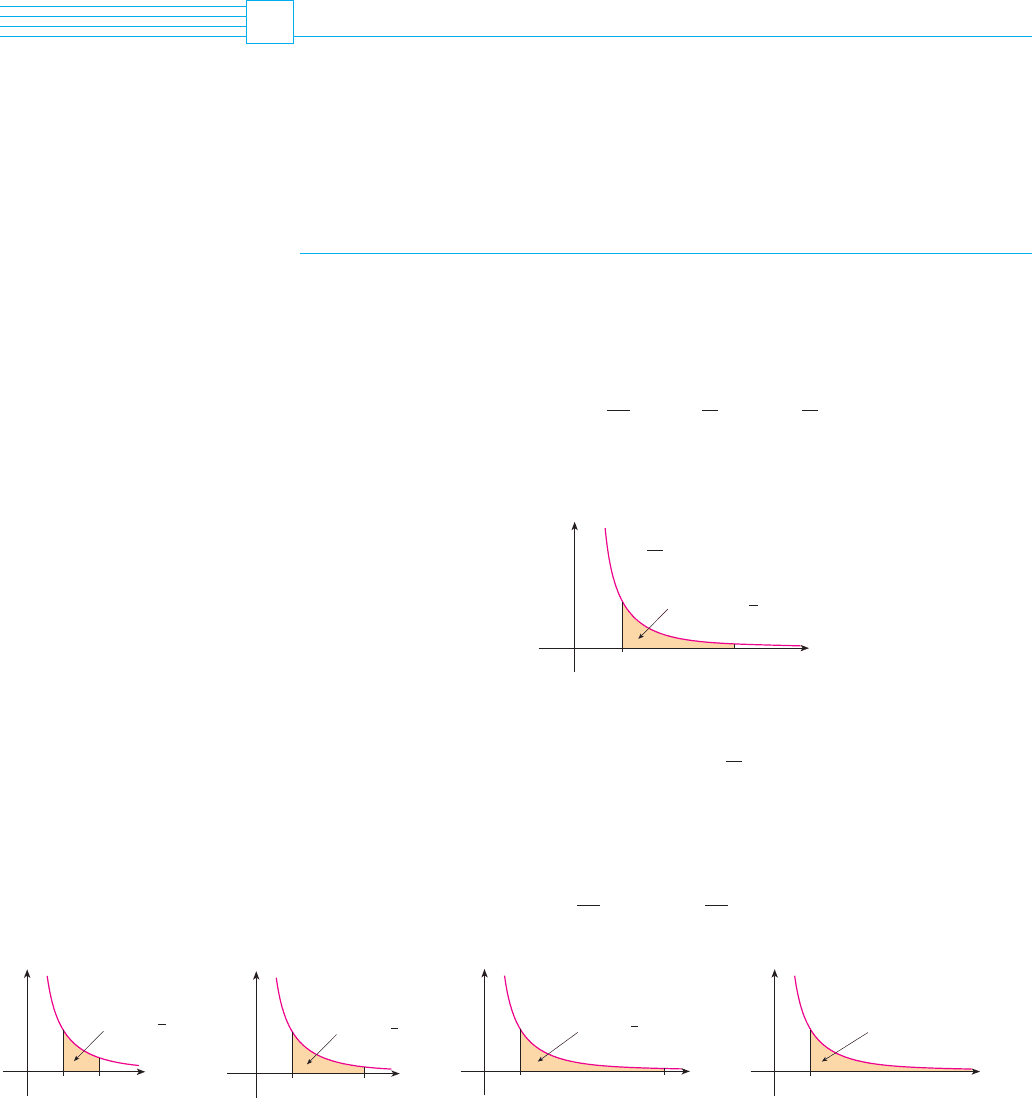
IMPROPER INTEGRALS
In defining a definite integral we dealt with a function defined on a finite inter-
val and we assumed that does not have an infinite discontinuity (see Section 5.2).
In this section we extend the concept of a definite integral to the case where the interval is
infinite and also to the case where has an infinite discontinuity in . In either case
the integral is called an improper integral. One of the most important applications of this
idea, probability distributions, will be studied in Section 9.5.
TYPE 1: INFINITE INTERVALS
Consider the infinite region that lies under the curve , above the -axis, and to
the right of the line . You might think that, since is infinite in extent, its area must
be infinite, but let’s take a closer look. The area of the part of that lies to the left of the
line (shaded in Figure 1) is
Notice that no matter how large is chosen.
We also observe that
The area of the shaded region approaches as (see Figure 2), so we say that the area
of the infinite region is equal to and we write
Using this example as a guide, we define the integral of (not necessarily a positive
function) over an infinite interval as the limit of integrals over finite intervals.
f
0
y
x
1
2
area=
1
2
0
y
x
1
3
area=
2
3
0
y
x
1
area=1
0
y
x
1
5
4
5
area=
F I G U R E 2
y
0
1
1
x
2
dx ! lim
t l 0
y
t
1
1
x
2
dx ! 1
1S
t l 01
lim
t l 0
A!t# ! lim
t l 0
&
1 $
1
t
'
! 1
F I G U R E 1
0
y
x
1
t
y=
x=1
area=1-=1
1
t
1
≈
tA!t#
)
1
A!t# !
y
t
1
1
x
2
dx ! $
1
x
,
1
t
! 1 $
1
t
x ! t
S
Sx ! 1
xy ! 1"x
2
S
(a, b)f
f(a, b)
fx
b
a
f !x# dx
8.8
544
|| ||
CHAPTER 8 TECHNIQUES OF INTEGRATION
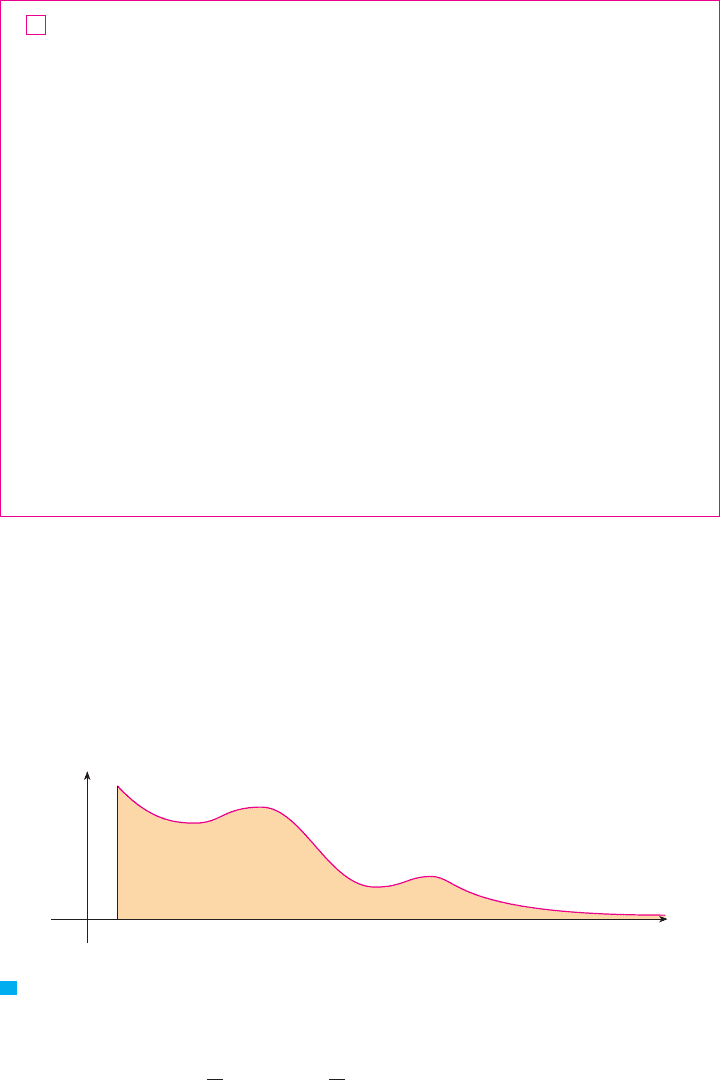
DEFINITION OF AN IMPROPER INTEGRAL OF TYPE 1
(a) If exists for every number , then
provided this limit exists (as a finite number).
(b) If exists for every number , then
provided this limit exists (as a finite number).
The improper integrals and are called convergent if the
corresponding limit exists and divergent if the limit does not exist.
(c) If both and are convergent, then we define
In part (c) any real number can be used (see Exercise 74).
Any of the improper integrals in Definition 1 can be interpreted as an area provided that
is a positive function. For instance, in case (a) if and the integral
is convergent, then we define the area of the region in
Figure 3 to be
This is appropriate because is the limit as of the area under the graph of
from to .
EXAMPLE 1 Determine whether the integral is convergent or divergent.
SOLUTION According to part (a) of Definition 1, we have
The limit does not exist as a finite number and so the improper integral is
divergent. M
x
0
1
!1"x# dx
! lim
t l 0
!ln t $ ln 1# ! lim
t l 0
ln t ! 0
y
0
1
1
x
dx ! lim
t l 0
y
t
1
1
x
dx ! lim
t l 0
ln
$
x
$
]
1
t
x
0
1
!1"x# dx
V
F I G U R E 3
0
y
x
a
S
y=ƒ
taf
t l 0x
0
a
f !x# dx
A!S# !
y
0
a
f !x# dx
S ! -!x, y#
$
x * a, 0 % y % f !x#.
x
0
a
f !x# dxf !x# * 0f
a
y
0
$0
f !x# dx !
y
a
$0
f !x# dx !
y
0
a
f !x# dx
x
a
$0
f !x# dxx
0
a
f !x# dx
x
b
$0
f !x# dxx
0
a
f !x# dx
y
b
$0
f !x# dx ! lim
t l $0
y
b
t
f !x# dx
t % bx
b
t
f !x# dx
y
0
a
f !x# dx ! lim
t l 0
y
t
a
f !x# dx
t * a
x
t
a
f !x# dx
1
SECTION 8.8 IMPROPER INTEGRALS
|| ||
545
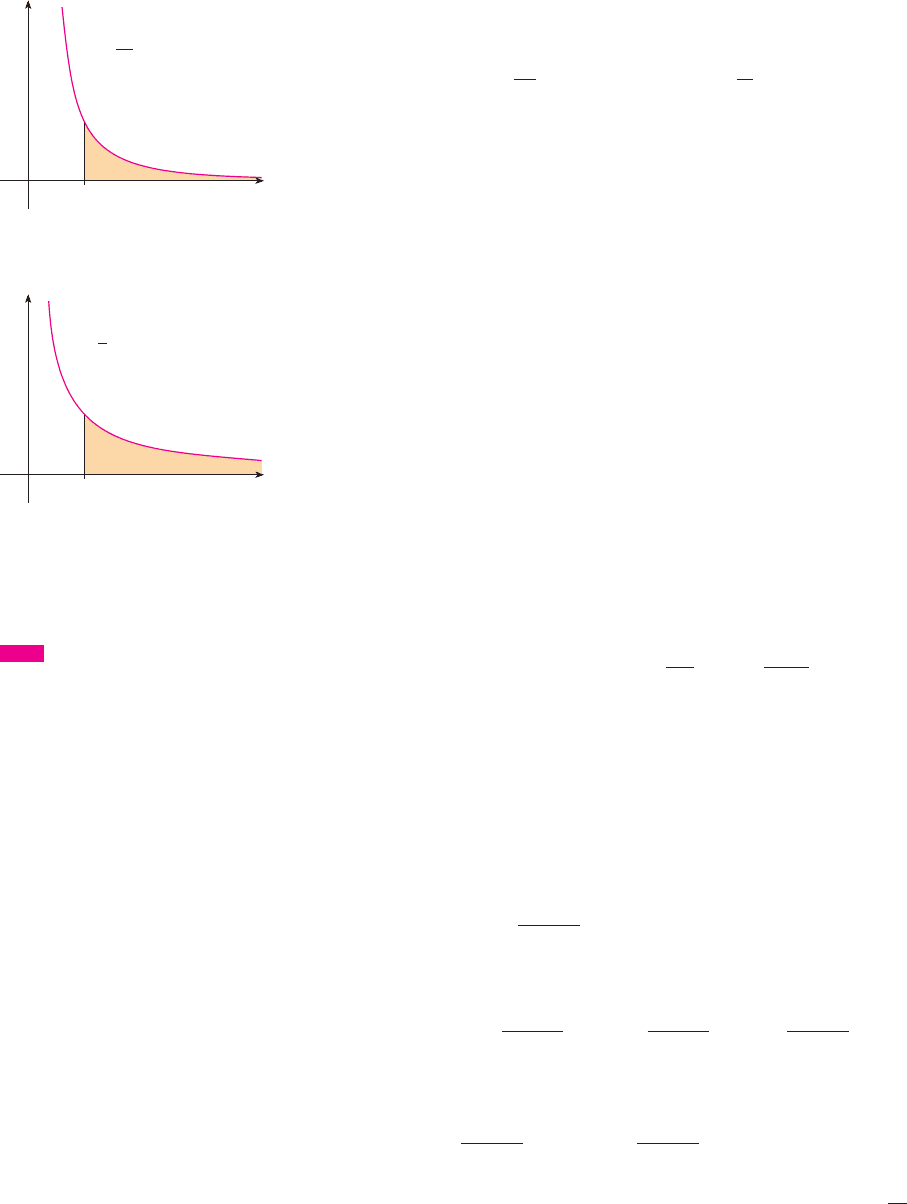
Let’s compare the result of Example 1 with the example given at the beginning of this
section:
Geometrically, this says that although the curves and look very similar
for , the region under to the right of (the shaded region in Figure 4)
has finite area whereas the corresponding region under (in Figure 5) has infinite
area. Note that both and approach as but approaches faster than
. The values of 1"x don’t decrease fast enough for its integral to have a finite value.
EXAMPLE 2 Evaluate .
SOLUTION Using part (b) of Definition 1, we have
We integrate by parts with , so that , :
We know that as , and by l’Hospital’s Rule we have
Therefore
M
EXAMPLE 3 Evaluate .
SOLUTION It’s convenient to choose in Definition 1(c):
We must now evaluate the integrals on the right side separately:
! lim
t
l
0
!tan
$1
t $ tan
$1
0# ! lim
t
l
0
tan
$1
t !
+
2
y
0
0
1
1 ! x
2
dx ! lim
t l 0
y
t
0
dx
1 ! x
2
! lim
t l 0
tan
$1
x
]
0
t
y
0
$0
1
1 ! x
2
dx !
y
0
$0
1
1 ! x
2
dx !
y
0
0
1
1 ! x
2
dx
a ! 0
y
0
$0
1
1 ! x
2
dx
! $0 $ 1 ! 0 ! $1
y
0
$0
xe
x
dx ! lim
t l $0
!$te
t
$ 1 ! e
t
#
! lim
t l $0
!$e
t
# ! 0
lim
t l $0
te
t
! lim
t l $0
t
e
$t
! lim
t l $0
1
$e
$t
t l $0e
t
l 0
! $te
t
$ 1 ! e
t
y
0
t
xe
x
dx ! xe
x
]
t
0
$
y
0
t
e
x
dx
v ! e
x
du ! dxdv ! e
x
dxu ! x
y
0
$0
xe
x
dx ! lim
t l $0
y
0
t
xe
x
dx
y
0
$0
xe
x
dx
1"x
01"x
2
x l 001"x1"x
2
y ! 1"x
x ! 1y ! 1"x
2
x ( 0
y ! 1"xy ! 1"x
2
y
0
1
1
x
dx diverges
y
0
1
1
x
2
dx converges
546
|| ||
CHAPTER 8 TECHNIQUES OF INTEGRATION
1
x
F I G U R E 4
F I G U R E 5
infinite area
0
y
x
1
y=
0
y
x
1
finite area
y=
1
≈
In Module 8.8 you can investigate
visually and numerically whether several
improper integrals are convergent or
divergent.
TE C
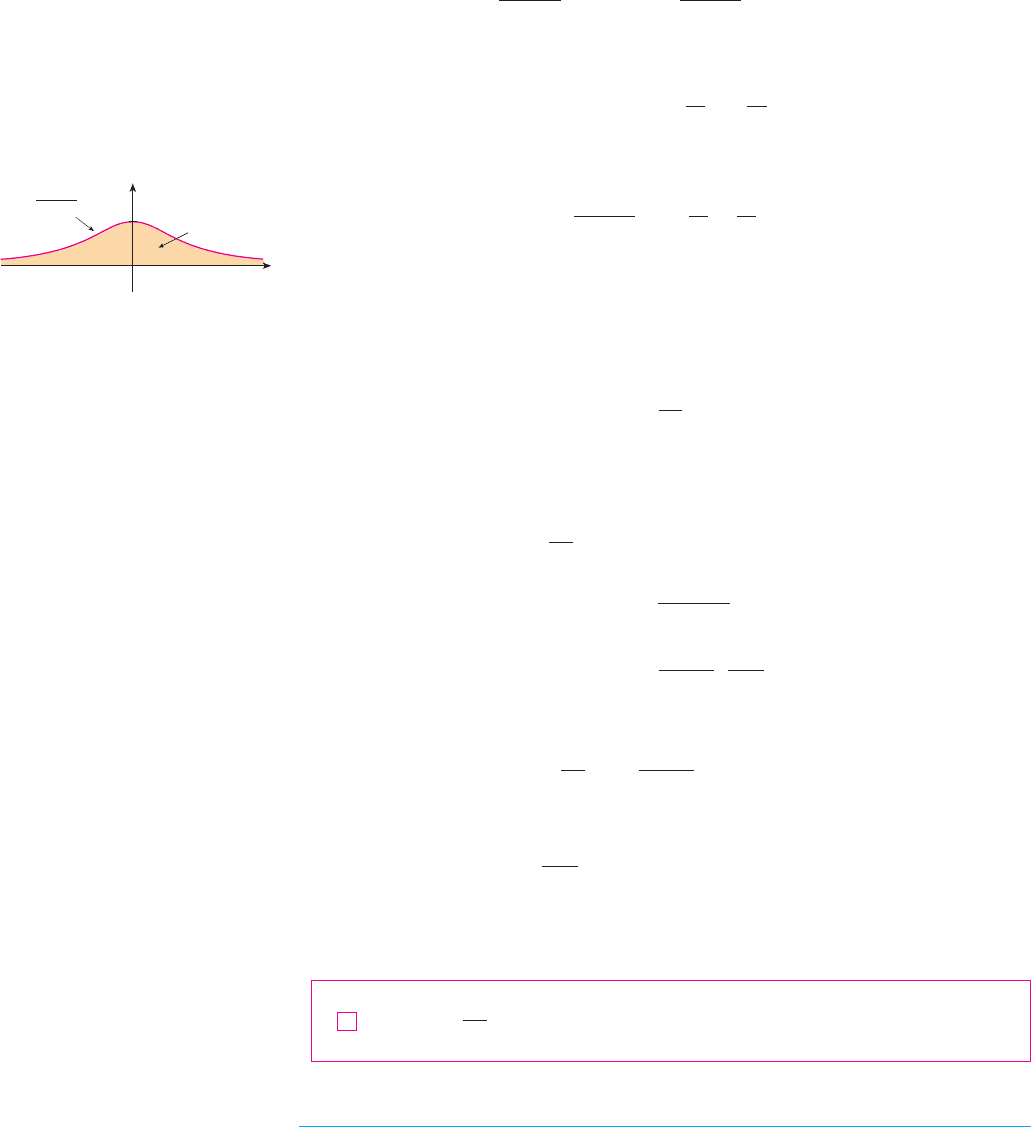
Since both of these integrals are convergent, the given integral is convergent and
Since , the given improper integral can be interpreted as the area of
the infinite region that lies under the curve and above the -axis (see
Figure 6). M
EXAMPLE 4 For what values of is the integral
convergent?
SOLUTION We know from Example 1 that if , then the integral is divergent, so let’s
assume that . Then
If , then , so as , and . Therefore
and so the integral converges. But if , then and so
and the integral diverges.
M
We summarize the result of Example 4 for future reference:
TYPE 2: DISCONTINUOUS INTEGRANDS
Suppose that is a positive continuous function defined on a finite interval but has
a vertical asymptote at . Let be the unbounded region under the graph of and above
the -axis between and . (For Type 1 integrals, the regions extended indefinitely in a bax
fSb
(a, b#f
y
0
1
1
x
p
dx is convergent if p ( 1 and divergent if p % 1.
2
as t l 0
1
t
p$1
! t
1$p
l 0
p $ 1
)
0p
)
1
if p ( 1
y
0
1
1
x
p
dx !
1
p $ 1
1"t
p$1
l 0t
p$1
l 0t l 0p $ 1 ( 0p ( 1
! lim
t
l
0
1
1 $ p
/
1
t
p$1
$ 1
,
! lim
t
l
0
x
$p!1
$p ! 1
,
x!1
x!t
y
0
1
1
x
p
dx ! lim
t
l
0
y
t
1
x
$p
dx
p " 1
p ! 1
y
0
1
1
x
p
dx
p
xy ! 1"!1 ! x
2
#
1"!1 ! x
2
# ( 0
y
0
$0
1
1 ! x
2
dx !
+
2
!
+
2
!
+
! 0 $
&
$
+
2
'
!
+
2
! lim
t
l
$0
!tan
$1
0 $ tan
$1
t#
y
0
$0
1
1 ! x
2
dx ! lim
t
l
$0
y
0
t
dx
1 ! x
2
! lim
t
l
$0
tan
$1
x
]
t
0
SECTION 8.8 IMPROPER INTEGRALS
|| ||
547
0
y
x
y=
area=π
F I G U R E 6
1
1+≈
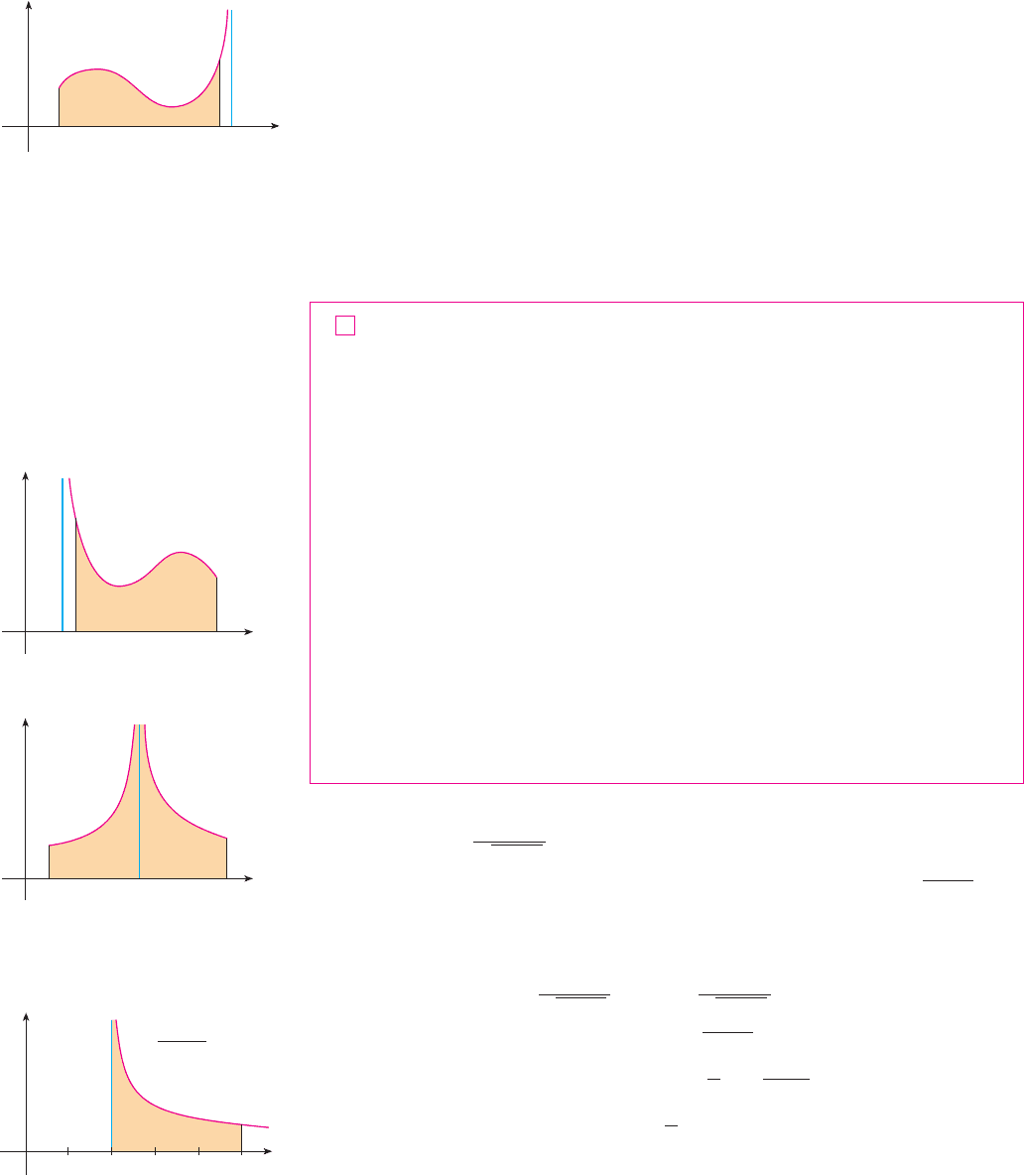
horizontal direction. Here the region is infinite in a vertical direction.) The area of the part
of between and (the shaded region in Figure 7) is
If it happens that approaches a definite number as , then we say that the
area of the region is and we write
We use this equation to define an improper integral of Type 2 even when is not a posi-
tive function, no matter what type of discontinuity has at .
DEFINITION OF AN IMPROPER INTEGRAL OF TYPE 2
(a) If is continuous on and is discontinuous at , then
if this limit exists (as a finite number).
(b) If is continuous on and is discontinuous at , then
if this limit exists (as a finite number).
The improper integral is called convergent if the corresponding limit
exists and divergent if the limit does not exist.
(c) If has a discontinuity at , where , and both and
are convergent, then we define
EXAMPLE 5 Find .
SOLUTION We note first that the given integral is improper because
has the vertical asymptote . Since the infinite discontinuity occurs at the left end-
point of , we use part (b) of Definition 3:
Thus the given improper integral is convergent and, since the integrand is positive, we
can interpret the value of the integral as the area of the shaded region in Figure 10. M
! 2
s
3
! lim
t
l
2
!
2
(
s
3
"
s
t " 2
)
! lim
t
l
2
!
2
s
x " 2
]
t
5
y
5
2
dx
s
x " 2
! lim
t
l
2
!
y
5
t
dx
s
x " 2
!2, 5"
x ! 2
f #x$ ! 1%
s
x " 2
y
5
2
1
s
x " 2
dx
y
b
a
f #x$ dx !
y
c
a
f #x$ dx !
y
b
c
f #x$ dx
x
b
c
f #x$ dx
x
c
a
f #x$ dxa
#
c
#
bcf
x
b
a
f #x$ dx
y
b
a
f #x$ dx ! lim
t l a
!
y
b
t
f #x$ dx
a#a, b"f
y
b
a
f #x$ dx ! lim
t
l
b
"
y
t
a
f #x$ dx
b!a, b$f
3
bf
f
y
b
a
f #x$ dx ! lim
t
l
b
"
y
t
a
f #x$ dx
AS
t l b
"
AA#t$
A#t$ !
y
t
a
f #x$ dx
taS
548
|| ||
CHAPTER 8 TECHNIQUES OF INTEGRATION
F I G U R E 7
0
y
x
bta
x=b
y=ƒ
N Parts (b) and (c) of Definition 3 are illustrated
in Figures 8 and 9 for the case where
and has vertical asymptotes at and ,
respectively.
caf
f #x$ $ 0
0
y
x
a t b
F I G U R E 8
0
y
x
a c b
F I G U R E 9
0
y
x
1 2 4 53
y=
1
œ„„„
„
x-2
area=2œ
„
3
F I G U R E 1 0

EXAMPLE 6 Determine whether converges or diverges.
SOLUTION Note that the given integral is improper because . Using
part (a) of Definition 3 and Formula 14 from the Table of Integrals, we have
because and as . Thus the given improper integral is
divergent. M
EXAMPLE 7 Evaluate if possible.
SOLUTION Observe that the line is a vertical asymptote of the integrand. Since it
occurs in the middle of the interval , we must use part (c) of Definition 3 with
:
where
because as . Thus is divergent. This implies that
is divergent. [We do not need to evaluate .] M
|
WARNING
If we had not noticed the asymptote in Example 7 and had instead
confused the integral with an ordinary integral, then we might have made the following
erroneous calculation:
This is wrong because the integral is improper and must be calculated in terms of limits.
From now on, whenever you meet the symbol you must decide, by looking
at the function on , whether it is an ordinary definite integral or an improper
integral.
EXAMPLE 8 Evaluate .
SOLUTION We know that the function has a vertical asymptote at 0 since
. Thus the given integral is improper and we have
y
1
0
ln x dx ! lim
t
l
0
!
y
1
t
ln x dx
lim
x l 0
!
ln x ! "%
f #x$ ! ln x
y
1
0
ln x dx
!a, b"f
x
b
a
f #x$ dx
y
3
0
dx
x " 1
! ln
&
x " 1
&
]
3
0
! ln 2 " ln 1 ! ln 2
x ! 1
x
3
1
dx%#x " 1$x
3
0
dx%#x " 1$
x
1
0
dx%#x " 1$t l 1
"
1 " t l 0
!
! lim
t
l
1
"
ln#1 " t$ ! "%
! lim
t
l
1
"
(
ln
&
t " 1
&
" ln
&
"1
&
)
y
1
0
dx
x " 1
! lim
t
l
1
"
y
t
0
dx
x " 1
! lim
t
l
1
"
ln
&
x " 1
&
]
0
t
y
3
0
dx
x " 1
!
y
1
0
dx
x " 1
!
y
3
1
dx
x " 1
c ! 1
!0, 3"
x ! 1
y
3
0
dx
x " 1
t l #
&
%2$
"
tan t l %sec t l %
! lim
t
l
#
&
%2$
"
!ln#sec t ! tan t$ " ln 1" ! %
! lim
t
l
#
&
%2$
"
ln
&
sec x ! tan x
&
]
0
t
y
&
%2
0
sec x dx ! lim
t
l
#
&
%2$
"
y
t
0
sec x dx
lim
x l #
&
%2$
"
sec x ! %
y
&
%2
0
sec x dx
V
SECTION 8.8 IMPROPER INTEGRALS
|| ||
549
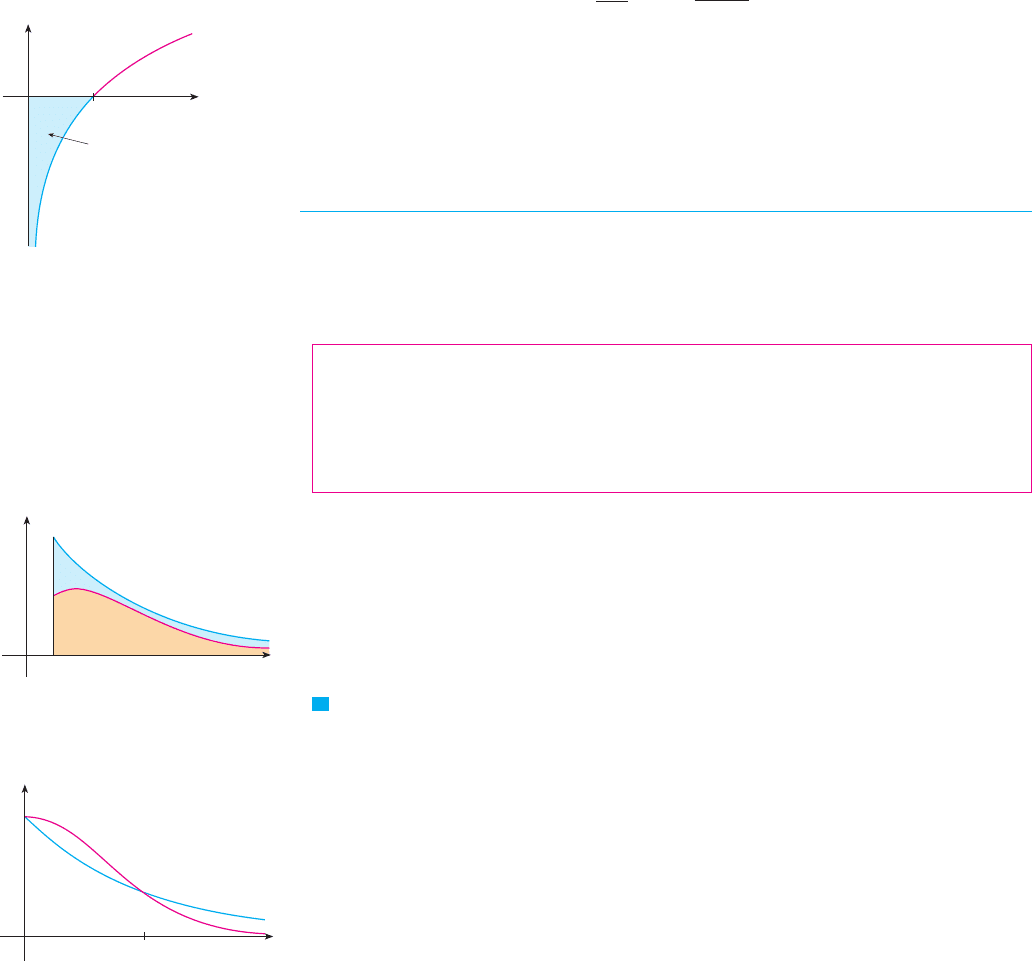
Now we integrate by parts with , , , and :
To find the limit of the first term we use l’Hospital’s Rule:
Therefore
Figure 11 shows the geometric interpretation of this result. The area of the shaded region
above and below the -axis is . M
A COMPARISON TEST FOR IMPROPER INTEGRALS
Sometimes it is impossible to find the exact value of an improper integral and yet it
is important to know whether it is convergent or divergent. In such cases the following the-
orem is useful. Although we state it for Type 1 integrals, a similar theorem is true for
Type 2 integrals.
COMPARISON THEOREM Suppose that and are continuous functions with
for .
(a) If is convergent, then is convergent.
(b) If is divergent, then is divergent.
We omit the proof of the Comparison Theorem, but Figure 12 makes it seem plausible.
If the area under the top curve is finite, then so is the area under the bottom curve
. And if the area under is infinite, then so is the area under .
[Note that the reverse is not necessarily true: If is convergent, may
or may not be convergent, and if is divergent, may or may not be
divergent.]
EXAMPLE 9 Show that is convergent.
SOLUTION We can’t evaluate the integral directly because the antiderivative of is not an
elementary function (as explained in Section 8.5). We write
and observe that the first integral on the right-hand side is just an ordinary definite inte-
gral. In the second integral we use the fact that for we have , so
and therefore . (See Figure 13.) The integral of is easy to evaluate:
! lim
t
l
%
#e
"1
" e
"t
$ ! e
"1
y
%
1
e
"x
dx ! lim
t
l
%
y
t
1
e
"x
dx
e
"x
e
"x
2
' e
"x
"x
2
' "xx
2
$ xx $ 1
y
%
0
e
"x
2
dx !
y
1
0
e
"x
2
dx !
y
%
1
e
"x
2
dx
e
"x
2
y
%
0
e
"x
2
dx
V
x
%
a
t#x$ dxx
%
a
f #x$ dx
x
%
a
f #x$ dxx
%
a
t#x$ dx
y ! f #x$y ! t#x$y ! t#x$
y ! f #x$
x
%
a
f #x$ dxx
%
a
t#x$ dx
x
%
a
t#x$ dxx
%
a
f #x$ dx
x $ af #x$ $ t#x$ $ 0
tf
1xy ! ln x
! "0 " 1 ! 0 ! "1
y
1
0
ln x dx ! lim
t
l
0
!
#"t ln t " 1 ! t$
! lim
t
l
0
!
#"t$ ! 0! lim
t
l
0
!
1%t
"1%t
2
lim
t
l
0
!
t ln t ! lim
t
l
0
!
ln t
1%t
! "t ln t " 1 ! t
! 1 ln 1 " t ln t " #1 " t$
y
1
t
ln x dx ! x ln x
]
t
1
"
y
1
t
dx
v ! xdu ! dx%xdv ! dxu ! ln x
550
|| ||
CHAPTER 8 TECHNIQUES OF INTEGRATION
F I G U R E 1 1
0
y
x
1
area=1
y=lnx
0
y
x
a
g
f
F I G U R E 1 2
0
y
x
1
y=e
_x
F I G U R E 1 3
y=e
_x
2

Thus, taking and in the Comparison Theorem, we see that
is convergent. It follows that is convergent.
M
In Example 9 we showed that is convergent without computing its value. In
Exercise 70 we indicate how to show that its value is approximately 0.8862. In probabil-
ity theory it is important to know the exact value of this improper integral, as we will see
in Section 9.5; using the methods of multivariable calculus it can be shown that the exact
value is . Table 1 illustrates the definition of an improper integral by showing how
the (computer-generated) values of approach as t becomes large. In fact,
these values converge quite quickly because very rapidly as .
EXAMPLE 10
The integral is divergent by the Comparison Theorem
because
and is divergent by Example 1 [or by (2) with ].
M
Table 2 illustrates the divergence of the integral in Example 10. It appears that the
values are not approaching any fixed number.
p ! 1
x
%
1
#1%x$ dx
1 ! e
"x
x
(
1
x
y
%
1
1 ! e
"x
x
dx
x l %e
"x
2
l 0
s
&
%2
x
t
0
e
"x
2
dx
s
&
%2
x
%
0
e
"x
2
dx
x
%
0
e
"x
2
dx
x
%
1
e
"x
2
dx
t#x$ ! e
"x
2
f #x$ ! e
"x
SECTION 8.8 IMPROPER INTEGRALS
|| ||
551
TA B L E 1
t
1 0.7468241328
2 0.8820813908
3 0.8862073483
4 0.8862269118
5 0.8862269255
6 0.8862269255
x
t
0
e
"x
2
dx
TA B L E 2
t
2 0.8636306042
5 1.8276735512
10 2.5219648704
100 4.8245541204
1000 7.1271392134
10000 9.4297243064
x
t
1
!#1 ! e
"x
$%x" dx
8.
9. 10.
11. 12.
14.
15. 16.
17. 18.
19. 20.
22.
23. 24.
25. 26.
27. 28.
y
3
2
1
s
3 " x
dx
y
1
0
3
x
5
dx
y
%
0
x arctan x
#1 ! x
2
$
2
dx
y
%
e
1
x#ln x$
3
dx
y
%
0
e
x
e
2x
! 3
dx
y
%
"%
x
2
9 ! x
6
dx
y
%
"%
x
3
e
"x
4
dx
y
%
1
ln x
x
dx
21.
y
6
"%
re
r%3
dr
y
%
0
se
"5s
ds
y
%
0
dz
z
2
! 3z ! 2
y
%
1
x ! 1
x
2
! 2x
dx
y
%
"%
cos
&
t dt
y
%
2
&
sin
)
d
)
y
%
1
e
"
s
x
s
x
dx
y
%
"%
xe
"x
2
dx
13.
y
%
"%
#2 "
v
4
$ d
v
y
%
"%
x
1 ! x
2
dx
y
"1
"%
e
"2t
dt
y
%
4
e
"y%2
dy
y
%
0
x
#x
2
! 2$
2
dx
y
"1
"%
1
s
2 "
w
d
w
7.
Explain why each of the following integrals is improper.
(a) (b)
(c) (d)
2. Which of the following integrals are improper? Why?
(a) (b)
(c) (d)
3.
Find the area under the curve from to
and evaluate it for , , and . Then find the total
area under this curve for .
;
4.
(a) Graph the functions and in the
viewing rectangles by and by .
(b) Find the areas under the graphs of and from
to and evaluate for , , , , ,
and .
(c) Find the total area under each curve for , if it exists.
5– 40
Determine whether each integral is convergent or divergent.
Evaluate those that are convergent.
5. 6.
y
0
"%
1
2x " 5
dx
y
%
1
1
#3x ! 1$
2
dx
x $ 1
10
20
10
10
10
6
10
4
100t ! 10x ! t
x ! 1tf
!0, 1"!0, 100"!0, 1"!0, 10"
t#x$ ! 1%x
0.9
f #x$ ! 1%x
1.1
x $ 1
1000100t ! 10
x ! tx ! 1y ! 1%x
3
y
2
1
ln#x " 1$ dx
y
%
"%
sin x
1 ! x
2
dx
y
1
0
1
2x " 1
dx
y
2
1
1
2x " 1
dx
y
0
"%
1
x
2
! 5
dx
y
2
0
x
x
2
" 5x ! 6
dx
y
&
%2
0
sec x dx
y
%
1
x
4
e
"x
4
dx
1.
E X E R C I S E S
8.8
Openmirrors.com
